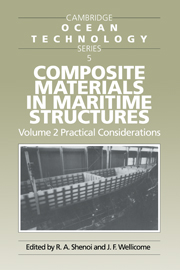Book contents
- Frontmatter
- Contents
- Preface
- List of Authors
- 1 Introduction
- 2 Design of Displacement Craft
- 3 Design of Dynamically Supported Craft
- 4 The Role of Adhesives
- 5 Practical Design of Joints and Attachments
- 6 Production of Ships with Single Skin Structures
- 7 Production of Yacht Hulls of Sandwich Configuration
- 8 Material Case Study - Failures and their Repairs
- 9 Response of Sandwich Structures to Slamming and Impact Loads
- 10 Fatigue Characteristics
- 11 Composites in Offshore Structures
- 12 Regulatory Aspects in Design
- 13 Quality and Safety Assessment
- 14 Design Management and Organisation
- Appendix
- Index
1 - Introduction
Published online by Cambridge University Press: 04 August 2010
- Frontmatter
- Contents
- Preface
- List of Authors
- 1 Introduction
- 2 Design of Displacement Craft
- 3 Design of Dynamically Supported Craft
- 4 The Role of Adhesives
- 5 Practical Design of Joints and Attachments
- 6 Production of Ships with Single Skin Structures
- 7 Production of Yacht Hulls of Sandwich Configuration
- 8 Material Case Study - Failures and their Repairs
- 9 Response of Sandwich Structures to Slamming and Impact Loads
- 10 Fatigue Characteristics
- 11 Composites in Offshore Structures
- 12 Regulatory Aspects in Design
- 13 Quality and Safety Assessment
- 14 Design Management and Organisation
- Appendix
- Index
Summary
This book deals mainly with practical issues related to the application of FRP composite materials in a maritime engineering context. The contents may be seen to fall under four, broad categories namely design aspects, production considerations, in-service or operationsrelated features and safety/quality management issues.
The next two chapters, related to the design of displacement vessels and dynamically-supported craft, emphasise the centrality of design. The two vessel types – a minehunter and a Surface Effect Ship – cover the extremes in terms of loading, structural topology, material configurations and operational scenarios. Whereas these chapters cover the overall aspects of preliminary design, the next two (Chapters 4 and 5) on adhesives and joints serve to underline the importance of detail considerations that need to be given to secondary bonding in FRP structures.
The second category of topics covered in the book relates to production factors. Again, an attempt has been made to cover the two “extremes” related to single skin stiffened and monocoque sandwich structures (Chapters 6 and 7). The former is the traditionally derived form for high quality naval vessels while the latter is increasingly favoured for smaller, more specialist craft such as yachts for America's Cup races.
The third category is related to operational considerations. Owners and operators of craft need to know the significance of defects such as cracks and blisters, as and when they appear, on performance and safety (Chapter 8). There is also a need to have an adequate understanding of the response of FRP structures to typical marine loadings and of possible failure patterns under large loads (Chapter 9).
- Type
- Chapter
- Information
- Composite Materials in Maritime Structures , pp. 1 - 2Publisher: Cambridge University PressPrint publication year: 1993

